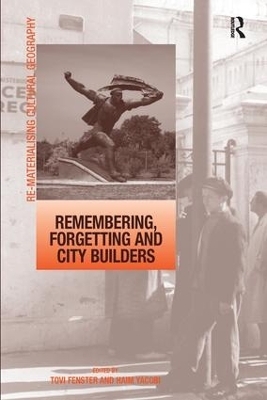
Remembering, Forgetting and City Builders
Routledge (Verlag)
978-1-138-27868-4 (ISBN)
Remembering, Forgetting and City Builders critically explores how urban spaces are designed, planned and experienced in relation to the politics of collective and personal memory construction. Bringing together case studies from North America, South Asia, Eastern Europe and the Middle East, the book analyzes how contested national, ethnic and cultural sentiments clash in planning and experiencing urban spaces. Going beyond the claim that such situations exist in many parts of the world because communities construct their 'past memories' within their current daily life and future aspirations, the book explores how the very acts of planning and urban design are rooted in the existing structures of hegemonic power. With contributors from the fields of architecture, geography, planning, anthropology and sociology, urban studies and cultural studies, the book provides a rich, interdisciplinary view into the conflicts over memory and belonging which are spatially expressed and mediated through the official planning apparatus.
Tovi Fenster, Tel Aviv University, Israel and Haim Yacobi, Ben Gurion University, Israel
Introduction, Haim Yacobi, Tovi Fenster; Chapter 1 Remembering Forgotten Landscapes: Community Gardens in New York City and the Reconstruction of Cultural Diversity, Efrat Eizenberg; Chapter 2 1This chapter was originally published in: Haim Yacobi, “From State-Imposed Urban Planning to Israeli Diasporic Place: The Case of Netivot and the Grave of Baba Sali”, in Julia Brauch, Anna Lipphardt and Alexandra Nocke (eds) Jewish Topographies: Visions of Space, Tradition and Place (Aldershot: Ashgate, ), 63–82., Sachin Haism; Chapter 3 Neighbourhood and Belonging: Turkish Immigrant Women Constructing the Everyday Public Space, Eda Ünlü-Yücesoy; Chapter 4 1Another version of this chapter has been published in: Ismael Abu-Saad and Oren Yiftachel, eds. HAGAR Studies in Culture, Polity and Identities, 8/2 Special Issue: Bedouin-Arab Society in the Negev/Naqab: Studies in Policy, Resistance and Development (Beersheba: Ben Gurion University, ), 93–120., Safa Abu-Rabia; Chapter 5 One Place – Different Memories: The Case of Yaad and Miaar, Tovi Fenster; Chapter 6 The Reconstructed City as Rhetorical Space: The Case of Volgograd, Elena Trubina; Chapter 7 *This chapter is a modified version of my Hebrew-language article “Se'ol: Hebetim shel havnayat zehut be-emtsa'ut ha-nof ha-ironi”, in Zikaron, Hashkahah, ve-Havnayat ha-Merhav, ed. Haim Yacobi and Tovi Fenster (Jerusalem: Hakibbutz Hameuchad and Van Leer Institute, forthcoming) (Hebrew)., Guy Podoler; Chapter 8 “We Shouldn’t Sell Our Country!”: The Reconfiguration of Jewish Urban Property and Ethno-National Political Discourses and Projects in (Post)Socialist Romania, Damiana Gabriela Otoiu; Chapter 9 Forgetting and Remembering: Frankfurt’s Altstadt after the Second World War, Marianne Rodenstein; Chapter 10 1This text is based on ongoing research regarding colonial architecture and urbanism in the Democratic Republic of the Congo and informed by a series of fieldtrips to Lubumbashi in the period 2000–2007. It forms a more concise and slightly modified version of a paper that was originally presented at the 1st symposium of the Ghent Africa Platform (GAP) in December 2007 and consequently published in Afrika Focus, 1 (2008): 11–30. I kindly thank the editors of Afrika Focus for their kind permission to republish this text., Johan Lagae; Chapter 11 Epilogue The Fragility of Memory and its Remedy Through Spatial Practices, Tali Hatuka;
| Erscheinungsdatum | 15.02.2017 |
|---|---|
| Verlagsort | London |
| Sprache | englisch |
| Maße | 156 x 234 mm |
| Gewicht | 453 g |
| Themenwelt | Naturwissenschaften ► Biologie ► Ökologie / Naturschutz |
| Naturwissenschaften ► Geowissenschaften ► Geografie / Kartografie | |
| Technik ► Architektur | |
| Technik ► Umwelttechnik / Biotechnologie | |
| ISBN-10 | 1-138-27868-8 / 1138278688 |
| ISBN-13 | 978-1-138-27868-4 / 9781138278684 |
| Zustand | Neuware |
| Haben Sie eine Frage zum Produkt? |
aus dem Bereich


